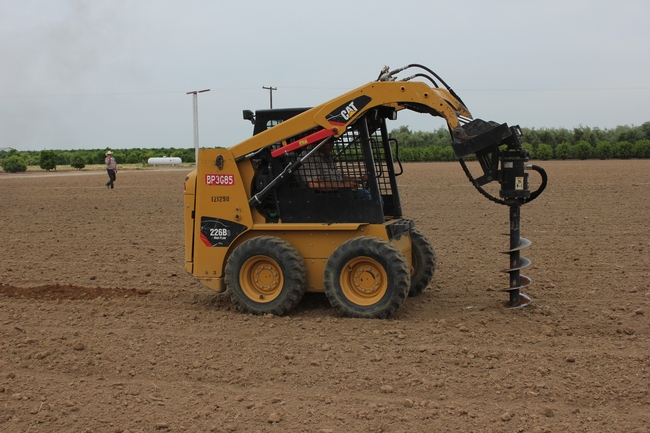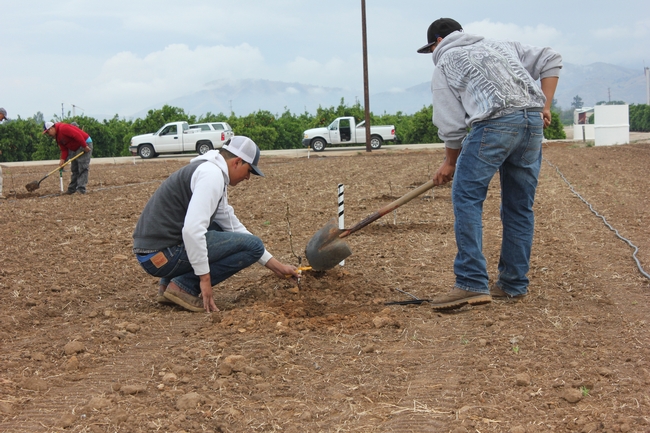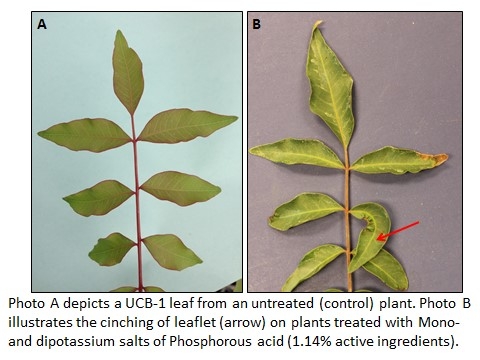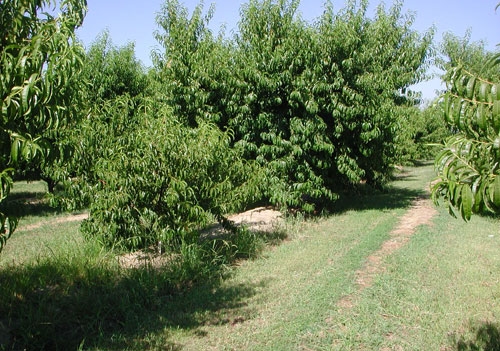Posts Tagged: rootstock
Lindcove REC Now Hosts Walnut Research
Lindcove Research and Extension Center (LREC) continues to diversify it's crop portfolio with the...

Don Cleek, LREC Ag Supervisor, augering tree holes in advance of planting.

Trees were planted in field capacity soil on April 11, 2016.
Gene expression in Lane Late navels
Rachel Rattner is beginning her 5th year in the Plant Biology Ph.D program at UC Riverside working...

Immature Lane Late navel fruit (Citrus sinensis)

Roots from sour orange rootstock (Citrus aurantium)
Implications of foliar phosphite applications on pistachio rootstock
California nut growers have benefited from the use of phosphite products, marketed and sold both as...

Pistachio leaf morphology
Meeting at Kearney helps stakeholders understand and detect Pistachio Bushy Top Syndrome.
Jennifer Randall, Research Associate Professor in the Department of Entomology, Plant Pathology and Weed Science at New Mexico State University provided a presentation on “Pistachio Bushy Top Syndrome: Disease etiology and diagnosis procedures" on April 7, 2015 at Kearney Agricultural Research and Extension Center (KARE).
The presentation was followed by a Q&A session conducted by Randall; Florent Trouillas, Assistant Cooperative Extension Specialist at KARE and in the Department of Plant Pathology at UC Davis specializing in fruit and nut crops; Craig Kallsen, UC Cooperative Extension advisor in Kern County, specializing in citrus, subtropical horticulture and pistachios; Robert Beede, UC Cooperative Extension advisor, emeritus, in Kings County, specializing in horticulture: tree fruit, nuts and grapes; and Elizabeth Fichtner, UC Cooperative Extension advisor in Tulare County, specializing in orchard systems.
Background: In the last few years, a new disease affecting UCB1 rootstocks emerged in CA, AZ, and NM. This disease was named Pistachio Bushy Top Syndrome (PBTS). Scientific evidence in 2014 demonstrated that PBTS is caused by the bacterium, Rhodococcus fascians (Rf). The percentage of rootstock exhibiting symptoms varies widely among plantings. At least 20,000 acres in CA have been affected to some extent. Two strains of Rf have been identified. Each is pathogenic, and they act synergistically to cause more severe disease symptoms. Pistachio growers in CA need to test for the pathogen in their newly planted orchards. This workshop attempted to bring academic, private and governmental diagnosis labs up to date on this new disease. Dr. Jennifer Randall from NMSU presented her group's latest research on the disease biology and detection methodologies.

Question and answer session at Kearney after a presentation on Pistachio Bushy Top Syndrome: disease etiology and diagnosis procedures.
Dwarfing rootstocks developed at Kearney cut peach farming expenses

UC Kearney Agricultural Research and Extension Center scientists have found that production costs can be cut dramatically by growing “dwarf” trees that minimize the need for ladder access. However, the limiting factor for peaches has been the lack of acceptable dwarfing rootstocks for the best peach varieties.
In 1987, UC and USDA scientists began a landmark rootstock evaluation project. More than 100 varieties that were either collected or bred by USDA plant breeder David Ramming were planted at Kearney. Five trees each of O'Henry peach and Santa Rosa plum were grafted on the rootstocks and extensively evaluated over the next seven years.
For peach, eight selections showed good potential as dwarfing or semi-dwarfing rootstocks and were propagated for further evaluation. In 2004, two of these were patented as the slightly dwarfing rootstock, “Controller 9,” and the very dwarfing rootstock, “Controller 5.”
At UC Davis, now retired researcher Fred Bliss bred rootstocks using Harrow Blood and Okinawa as parents. UC Davis pomologist Ted De Jong has taken over the program, which patented and released three new rootstocks: Controller 7, Controller 8 and Controller 9.5. A fourth, Controller 6, will be released soon.
The research blocks with Controller 6, 7, 8, and 9.5 at Kearney are continuing to be monitored for production performance and sustained productivity. So far, their performance looks positive but, because of funding cuts, the long-term outlook for maintaining the plots is questionable, De Jong said. UC Cooperative Extension farm advisor Kevin Day is conducting trials of “controller” rootstocks in conjunction with growers to help them determine which ones best fit their farming operations.
De Jong said there is significant interest in Controller 9 because it has been available the longest. Trees on Controller 9 are only slightly reduced in size but require significantly less pruning than trees on the standard rootstock, Nemaguard. There is also substantial interest in Controller 6 by growers who are more aggressive in their interest in smaller trees. Controller 6 causes a substantial reduction in tree size without reducing fruit size.
“I think that Controller 7 may be an optimal choice for many growers because it offers modest size-control and trees on it have had excellent production characteristics and is not such a large leap to a smaller tree,” De Jong said. “However there has been limited interest in it thus far.”
Controller 5 likely makes trees too small for commercial California peach production and trees on it tend to produce smaller fruit. However, it has good potential for home gardeners who have limited space, prefer not to prune much and aren’t very concerned about fruit size.
De Jong, Day, UC Davis pomology specialist Scott Johnson and numerous students have conducted extensive research concerning the dwarfing mechanism involved in these rootstocks and published more than 10 scientific articles on different aspects of the research. These articles and more information about the California Rootstock Breeding Program are available on the UC Fruit Report website.